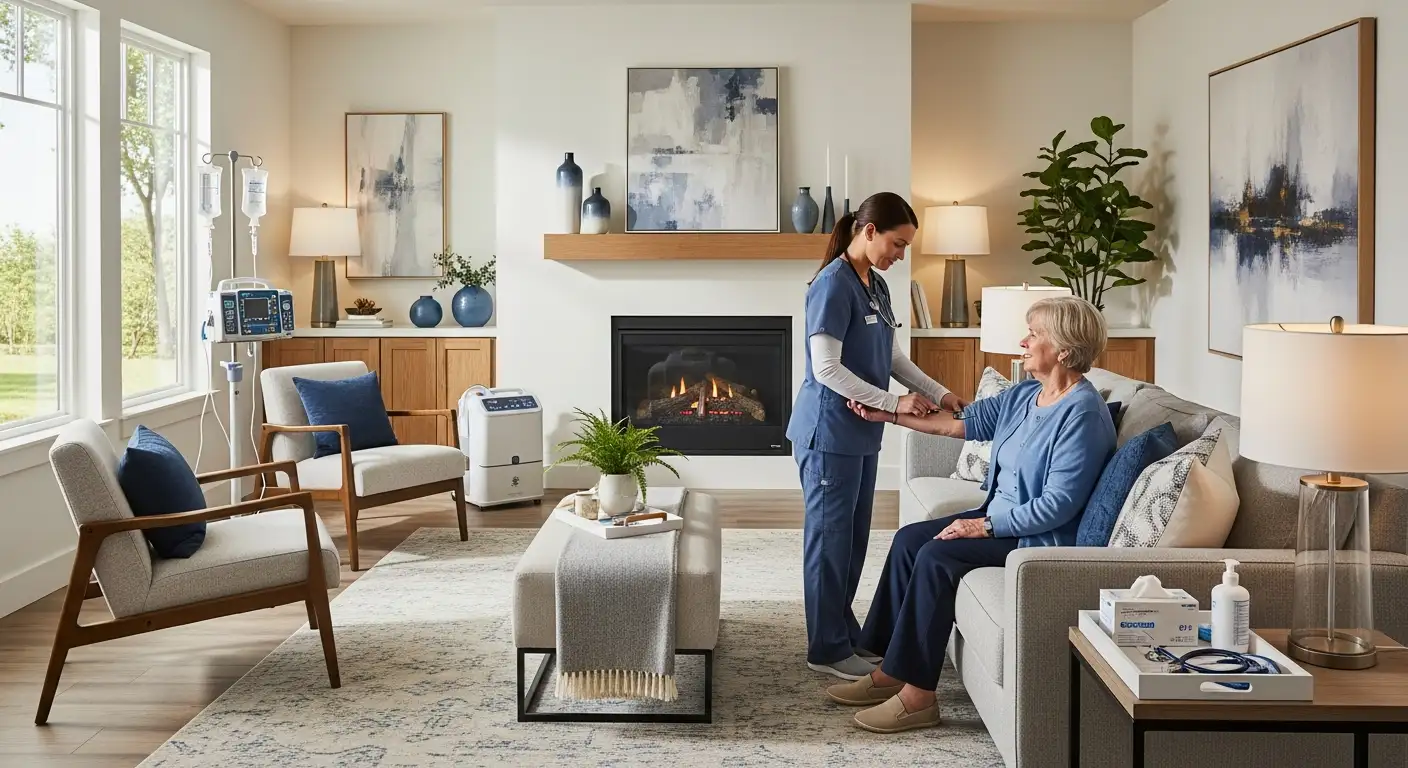Understanding the Needs of Ventilated Patients at Home
Adapting a home environment for a loved one on a ventilator involves careful planning, specialized equipment, and comprehensive caregiver training. Whether transitioning from hospital or establishing long-term home care, ensuring safety, accessibility, and emotional well-being is essential. This article provides an in-depth guide on how to create a supportive living space, manage equipment, and implement best practices to enhance quality of life for ventilated individuals.
Preparing the Home Environment for Safe Ventilator Use

What can family members expect when a loved one is on a ventilator?
When a loved one is on a ventilator, family members should be prepared for a range of conditions. The patient might be conscious or sedated and unable to speak, eat, or move normally—that's because the machine assists or manages their breathing. They receive oxygen through a tube inserted into their airway or via a face mask if noninvasive methods are used.
Caretakers will play a vital role in providing emotional support, monitoring the patient’s health, and assisting with recovery and communication. Medical supervision is critical throughout this process. As the patient stabilizes and improves, they may go through a withdrawal process called weaning, gradually decreasing ventilator support. Long-term use can also bring challenges such as physical weakness, cognitive changes, and emotional stress, which require ongoing care and support.
What should be known about the use of oxygen ventilators at home?
Using oxygen ventilators at home demands proper training for caregivers and patients. They need to understand how to set up, operate, and maintain the equipment, including changing trach tubes and recognizing early warning signs of issues. Typical equipment includes portable ventilators, backup devices, oxygen tanks, batteries, humidifiers, and monitors like pulse oximeters.
Regular equipment checks and maintaining detailed records of symptoms are essential for safe operation. Healthcare providers often recommend strict adherence to instructions, avoiding unauthorized adjustments, and practicing good hygiene—keeping the environment free of smoke and irritants. Advanced ventilators may combine multiple functions, such as automatic pressure adjustments and integrated oxygen delivery, improving comfort and safety.
What are the key considerations for adapting a home environment for someone on a ventilator?
Adapting the home environment involves several safety and accessibility measures. First, designate a dedicated space—preferably a living or dining area—that is near household activity and allows easy access to the patient. This space should be equipped with necessary medical devices, such as the ventilator, and have reliable power sources, like extra batteries and generators.
Environmental adjustments include improving air quality using HEPA filters, portable air cleaners, and ensuring proper ventilation through exhaust fans or open windows when appropriate. Proper caregiver training is vital, covering device operation, emergency procedures, tracheostomy care, and troubleshooting ventilator alarms. It is important to have at least two trained caregivers who can respond quickly to any issues.
Maintaining a clean environment is essential. Regular cleaning and sterilization of masks, tubing, and suction devices help prevent infections. Implementing air quality strategies and monitoring equipment remotely or through telehealth support ensures continuous oversight of the patient’s respiratory health.
What equipment considerations are important for home ventilator use?
Choosing the right equipment is fundamental. It depends on the patient’s specific needs—whether invasive or noninvasive ventilation—and the environment in which it will be used. Proper setup, safety, and maintenance are crucial.
Caregivers should receive comprehensive training on how to operate the ventilator, troubleshoot alarms, manage the airway, and respond to emergencies before the patient leaves the hospital. Ongoing support from respiratory therapists and healthcare teams enhances safety.
All devices, including masks, tubing, filters, and suction equipment, require regular cleaning and maintenance to prevent infections and ensure proper functioning. Monitoring features like remote connectivity can help track device performance and facilitate early interventions.
What are the different types of home ventilators and how do they compare?
Home ventilators primarily fall into two categories: portable and stationary units. Portable ventilators are small and lightweight, suited for patients who need mobility, while stationary ventilators are larger and designed for constant use at home.
They are also classified by the type of support they provide. Noninvasive ventilators, such as CPAP and BiPAP machines, use masks and are common for sleep apnea and less severe respiratory issues. Invasive ventilators require a tube inserted directly into the airway through a tracheostomy, used for more severe cases.
Modern ventilators typically deliver positive pressure air, adjusting pressures automatically or manually. They often include settings for PEEP (Positive End-Expiratory Pressure) to keep the alveoli open and improve oxygenation.
Choosing the appropriate ventilator depends on the patient’s medical condition, ability to tolerate the interface, and need for mobility. Proper training and environment adaptation help ensure the safe and effective use of these devices at home.
Implementing Safety Protocols and Caregiver Training

What safety measures should be taken when providing home ventilation care?
Providing safe home ventilation care involves several important steps. First, caregivers must receive thorough training on how to operate and maintain ventilator equipment, including skills like changing trach tubes and responding to alarms promptly. Regular checks of all devices ensure they function correctly, reducing the risk of unexpected failures. Keeping a record of symptoms and using monitoring devices such as pulse oximeters helps detect early signs of complications. Ensuring a stable power supply and having backup ventilators and oxygen tanks ready are crucial for emergencies. Infection prevention strategies like hand hygiene, head-of-bed elevation, and oral care minimize infection risks. Clear communication with healthcare professionals and ongoing education support safe management of ventilation at home.
Can a person be cared for at home while on a ventilator, and what training do caregivers need?
Yes, caring for a ventilated individual at home is possible with proper preparation. Caregivers require comprehensive training covering ventilator operation, troubleshooting, emergency responses, infection control, mucus clearance, and tracheostomy care if applicable. This training should begin before discharge, with hands-on practice and follow-up visits from respiratory therapists or nurses. Caregivers also learn to recognize serious signs like increased difficulty breathing or infections. Access to remote monitoring and professional support is vital for ongoing safety. Proper education helps caregivers respond quickly to issues, ensuring the patient’s comfort and stability.
What are the risks associated with home ventilator use and how can they be mitigated?
Risks such as infections (pneumonia and sinusitis), lung injuries, equipment failure, and skin breakdown can occur with home ventilation. To reduce these risks, routine maintenance, thorough pre-use checks, and strict infection control practice are essential. Caregivers should be trained to recognize signs of adverse events and respond appropriately. Maintaining proper cuff pressures, ensuring alarm systems are functional, and adhering to safety protocols provide further protection. Continual monitoring of vital signs and oxygen levels allows early detection of problems. Regular communication with healthcare teams helps tailor ventilator settings and actions, minimizing complications and enhancing patient safety.
How can families transition a ventilated patient from hospital to home care?
Transition planning begins with confirming that the patient is stable, with appropriate ventilator settings like oxygen demand and PEEP. Preparing caregivers involves comprehensive training in equipment use, troubleshooting, emergency response, and specialized pediatric care if needed. The home environment should be adapted with accessible features like ramps, handrails, and suitable furniture to support mobility and safety. Modern tools such as remote mask fitting techniques improve effectiveness. Coordinated efforts among multidisciplinary teams and continuous education ensure a smooth transition. Regular follow-up and telehealth support help monitor the patient’s progress, prevent readmissions, and promote long-term well-being.
What are the signs that a loved one is at the end of life while on a ventilator?
Indicators that a patient might be nearing the end of life include decreased responsiveness, falling strength, and changes in skin appearance like pallor or mottling. Breathing patterns may become irregular or slow, though ventilator settings can mask some signs; after stopping ventilation, breathing usually becomes labored and then ceases. Noises such as gasping can be present, signaling the body’s shutdown process. Caregivers should remain calm, provide comfort, and continue to communicate lovingly to support the patient emotionally.
What can family members expect when a loved one is on a ventilator?
Family members should be prepared for a range of experiences. The patient might be sedated or conscious, unable to speak or eat normally, and dependent on the ventilator for breathing. Support includes emotional comfort, monitoring the patient’s physical and emotional needs, and assisting with communication through gestures, notes, or eye contact. Medical teams typically oversee treatment, and as recovery progresses, the focus shifts to weaning and rehabilitative care. Challenges such as physical weakness or emotional distress are common, requiring ongoing support for both the patient and family. Ensuring open communication with healthcare providers helps families understand the process and plan for the patient’s journey.
Supporting Long-Term Home Ventilation
Adapting a home environment for a loved one on a ventilator is a comprehensive process that involves safety precautions, environmental adjustments, caregiver training, and ongoing medical support. Ensuring proper equipment setup, environmental safety, and caregiver readiness can significantly improve the quality of life and safety of the patient. Regular communication with healthcare providers, routine maintenance of equipment, and emotional support are essential components of successful home ventilation. With careful planning and coordination, families can create a safe, comfortable, and supportive space that meets the complex needs of ventilator-dependent individuals, allowing them to live at home with dignity and security.
References
- Going Home on a Ventilator - Nhlbi.nih.gov
- Family caregiver perspectives on caring for ventilator-assisted ...
- How To Support a Loved One on a Ventilator
- Powering Success in Home Mechanical Ventilation | RT
- Home Ventilator Services | Johns Hopkins Care at Home
- Adapting Your Home To Accommodate Your Ill Loved One
- How You Can Be There for a Loved One on a Ventilator During the ...
- Debunking 3 At-Home Ventilator Myths - Lincare



